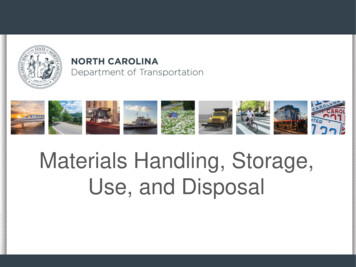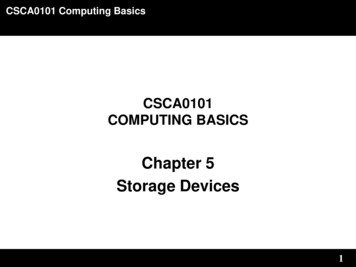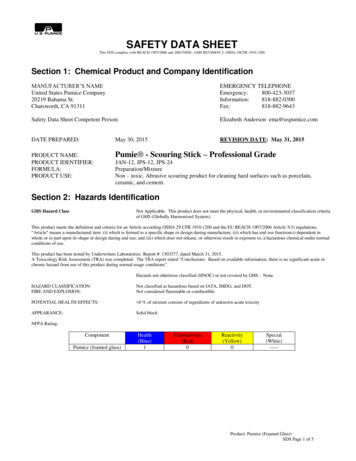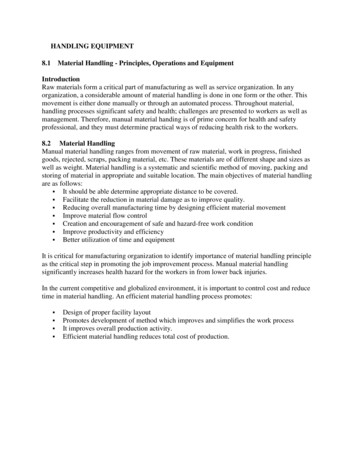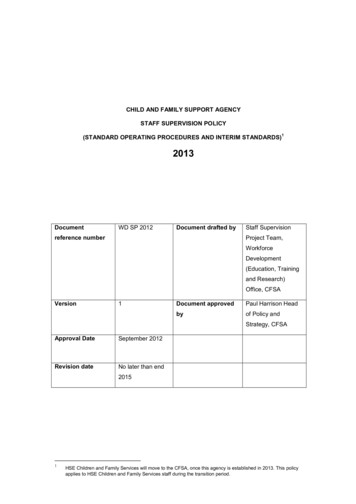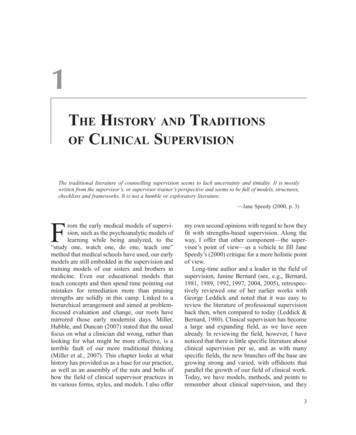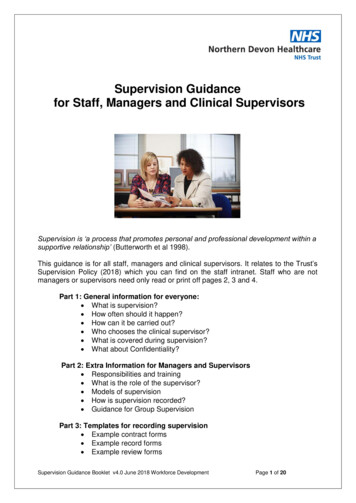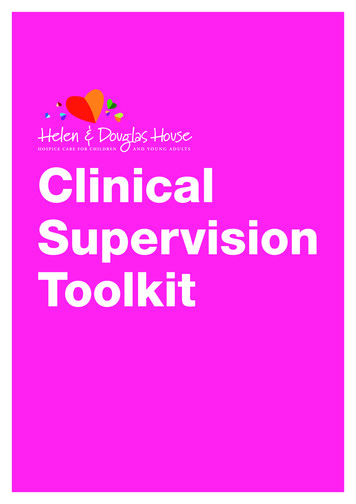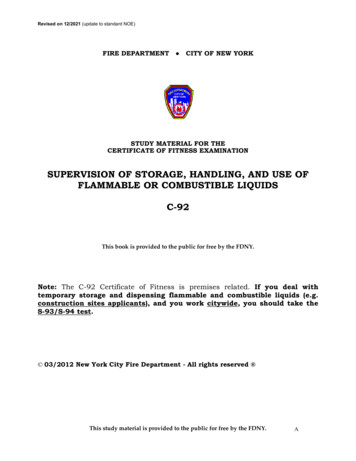
Transcription
Revised on 12/2021 (update to standard NOE)FIRE DEPARTMENT CITY OF NEW YORKSTUDY MATERIAL FOR THECERTIFICATE OF FITNESS EXAMINATIONSUPERVISION OF STORAGE, HANDLING, AND USE OFFLAMMABLE OR COMBUSTIBLE LIQUIDSC-92This book is provided to the public for free by the FDNY.Note: The C-92 Certificate of Fitness is premises related. If you deal withtemporary storage and dispensing flammable and combustible liquids (e.g.construction sites applicants), and you work citywide, you should take theS-93/S-94 test. 03/2012 New York City Fire Department - All rights reserved This study material is provided to the public for free by the FDNY.A
Revised on 12/2021 (update to standard NOE)CONTENTEXAM SPECIFIC INFORMATION FOR C-92 CERTIFICATE OF FITNESS . ISTUDY MATERIAL AND TEST DECRIPTION . IVINTRODUCTION .1Pre-existing and New Installations . 1Types of Permits . 2Hazardous Materials Reporting . 5Certificate of Fitness . 5Safety Data Sheets (SDS). 5Class of Flammable and Combustible Liquids . 6PART I. GENERAL REQUIREMENTS .71.2.DEFINITION . 7STORAGE .122.1 Container Storage and Indoor Storage .122.1.1Storage below grade. .122.1.2Quantity limits for indoor container storage.122.1.3Liquid storage cabinets .132.1.4General requirements for containers stored indoors. .132.1.5Containers storage arrangement .142.2 Outdoor Storage of Containers .152.2.1Protections and clearance from combustibles .152.2.2Empty containers storage .152.3 General Storage Requirements .152.3.1Clearance from incompatible materials .152.3.2Means of access to an exit .162.4 Tank Storage .162.4.1Change of tank contents .162.4.2Protections .162.4.3Overfill prevention .172.4.4Leaking detection for underground tanks .182.4.5Out of service storage systems .183.HANDLING AND USE .223.1 Liquid Transfer .223.2 Indoor Use.233.2.1Limitations on handling and use .233.3 Concentrated Alcohol-Based Hand Rubs .233.4 Manual Transfer of Fuel Oil for Emergency Generators in Buildings .244.LABELING AND SIGNS .254.1 NFPA Diamond Sign .254.2 Warning Signs and Labels .275.FIRE PROTECTION AND EMERGENCY RESPONSES.295.1 Different Types of Fire Extinguishers .315.2 Portable Fire Extinguisher Tags.335.3 Portable Fire Extinguisher Inspections .345.4 Emergency Procedures.355.4.1Fire notification .355.4.2Spill notification .356.SPECIAL REQUIREMENTS FOR DRY CLEANING .366.1 Certificate of Fitness and Supervision .366.2 Design and Installation Documents .366.3 Classifications .376.4 Requirements .376.4.1Ignition control .37This study material is provided to the public for free by the FDNY.B
Revised on 12/2021 (update to standard NOE)6.4.2Written instructions and identification .376.4.3Operation and maintenance requirements .386.4.4Inspections and testing .386.4.5Filling and emptying .396.5 Spotting and Pretreating.396.6 Fire Extinguishers .397.COMMON FLAMMABLE AND COMBUSTIBLE LIQUIDS .407.1 Flammable Liquids .407.1.1Class IA .407.1.2Class IB .427.1.3Class IC .447.2 Combustible Liquids .467.2.1Class II .467.2.2Class IIIA .497.3 Cleaning Fluids Used In Dry Cleaning Operations .50PART II. NEW OR MODIFIED INSTALLATIONS .528.STORAGE IN NEW INSTALLATION FACILITIES .528.1 Container Storage and Indoor Storage (New or Modified Installations) .528.1.1Maximum allowable quantity (MAQ) .528.1.2Liquid storage rooms and liquid warehouses .538.2 Outdoor Storage (New Installations) .558.2.1Quantity limits for outdoor container storage .558.3 Tank Storage (New Installations) .558.3.1Tank capacity limitations .559.HANDLING AND USE IN NEW INSTALLATION FACILITIES.579.1 Indoor Use (New Installations) .579.1.1Processing vessels.579.1.2Maximum allowable quantity for handling and use .579.2 Outdoor Use (New Installations) .5910.SPECIAL REGULATIONS FOR NEW INSTALLED GROUP M OCCUPANCIES .6110.1Storage, Handling and Use in Group M Occupancies .6110.2Wholesale and Retail Sales .61AppendixAppendixAppendixAppendixA. Hazardous Materials Report Forms .64B. Combustible Commodities .66C. Pre-existing Installations .68D. Fire protection system in Group M occupancy .72This study material is provided to the public for free by the FDNY.C
Revised on 12/2021 (update to standard NOE)TABLE INDEXTable 2- 1. The maximum allowable container capacity.12Table 5- 1.Flammable or combustible liquids with depths of less than or equal to 0.25-inch .29TableTableTableTableTableTable888888-1. Maximum allowable quantity of flammable liquids storage per control area .522.Maximum allowable quantity of combustible liquids storage for control area .533. Storage Arrangements for Palletized or Solid-pile Storage .544. Storage Arrangements for Rack Storage in Liquid Storage Rooms and Warehouses .545. Storage Arrangements for Outdoor Storage of Containers.556. Maximum capacity of flammable and combustible liquid storage tanks .56Table 9- 1. Location of processing vessels .57Table 9- 2. Maximum allowable quantity of flammable liquids for handling and use .58Table 9- 3.Maximum allowable quantity of combustible liquids for handling and use .59Table 9- 4.Maximum allowable quantity for dispensing of flammable and combustible liquids inoutdoor control areasa .60Table 10- 1.Maximum allowable quantity of flammable liquids in wholesale and retail sales usesfor control areaa.62Table 10- 2. Maximum allowable quantity of combustible liquids in wholesale and retail sales usesfor control areaa.63This study material is provided to the public for free by the FDNY.D
Revised on 12/2021 (update to standard NOE)EXAM SPECIFIC INFORMATION FORC-92 CERTIFICATE OF FITNESSSave time and submit application online!Applicants who submitted and paid online for an exam before arriving at theFDNY will not need to wait in line to enter the FDNY.It can take about 30 minutes to complete. Completing application and payingonline will eliminate waiting outside in the long lines.Instructions for online application and payment can be found /business/fdny-business-cof-individuals.pdfCreate an Account and Log in YCIDLogin.aspxREQUIREMENTS FOR CERTIFICATE OF FITNESS APPLICATIONGeneral requirements:Review the General Notice of /business/general-notice-of-exam-cof.pdfSpecial requirements for the C-92 Certificate of Fitness:The applicants who pass the C-92 Certificate of Fitness exam are allowed to pay theadditional 25 fee to obtain the S-94(supervising handling and dispensing flammable orcombustible liquids in portable containers) /C-93 (supervise of dry cleaning facilities)Certificate of Fitness without taking the exam(s).Do you work forconstruction sites?YESYou should take the S-93 examNOYou should take the C-92 examApplication fee (Cash is NO LONGER ACCEPTED):Pay the 25 application fee online or in person by one of the following methods: Credit card (American Express, Discover, MasterCard, or Visa) Debit card (MasterCard or Visa) In person: Personal or company check or money order (made payable to the NewYork City Fire Department)A convenience fee of 2% will be applied to all credit card payments.For fee waivers submit: (Only government employees who will use their COF for theirwork- related responsibilities are eligible for fee waivers.) A letter requesting fee waiver on the Agency’s official letterhead stating applicant fullname, exam type and address of premises; AND Copy of identification card issued by the agencyThis study material is provided to the public for free by the FDNY.I
Revised on 12/2021 (update to standard NOE)REQUIREMENTS FOR ALTERNATIVE ISSUANCE PROCEDURE(AIP)This Certificate of Fitness can be obtained by the alternative issuance procedure.Qualified applicants should review and complete the C-92 Certificate of FitnessAlternative Issuance Procedure Application Affirmation f/business/cof-c92-aip.pdfThe AIP applicants must submit the application, required documents and payment onFDNY Business:https://fires.fdnycloud.org/EXAM INFORMATIONThe C-92 exam will consist of 50 multiple-choice questions, administered on a “touchscreen” computer monitor. It is a time-limit exam. Based on the amount of the questionsand reference material provided, you will have 76 minutes to complete the test. A passingscore of at least 70% is required in order to secure a Certificate of Fitness.Call (718) 999-1988 for additional information and forms.Special material provided during the exam: The tables which appear in thebooklet will be provided to you as a reference material when you take the exam atMetroTech, however, the booklet will not provide to you during the exam.Please always check for the latest revised booklet at FDNY website before you take pdf/business/cof-c92-noe-study-materials.pdfThis study material is provided to the public for free by the FDNY.II
Revised on 12/2021 (update to standard NOE)EXAM SITE:FDNY Headquarters, 9 MetroTech Center, Brooklyn, NY. Enter through theFlatbush Avenue entrance (between Myrtle Avenue and Tech Place).RENEWAL REQUIREMENTSGeneral renewal requirements:Review the General Notice of f/business/general-notice-of-exam-cof.pdfSpecial renewal requirements. C-92 Certificate of Fitness: NoneQUESTIONS?FDNY Business Support Team: For questions, call 311 and ask for the FDNYCustomer Service Center or send an email to FDNY.BusinessSupport@fdny.nyc.gov.This study material is provided to the public for free by the FDNY.III
Revised on 12/2021 (update to standard NOE)STUDY MATERIAL AND TEST DECRIPTIONThis study material contains the information you will need to prepare for supervisingstorage, handling and use of flammable or combustible liquids. It will not be providedto you during the test. It is critical that you read and understand this booklet tohelp increase your chance of passing this exam. The study material does not containall of the information you need to know to supervise the storage, handling and use offlammable or combustible liquids. It is your responsibility to become familiar with allapplicable rules and regulations of the City of New York, even if they are not covered inthis study material. You need to be familiar with the Fire Code Chapter 27 and Chapter34, and NFPA 30 which regulate the storage, handling and use of flammable orcombustible liquids in order to adequately prepare for the exam.About the TestThe C-92 test will consist of 50 multiple-choice questions, administered on a “touchscreen” computer monitor. It is a time-limit test. Only one answer is most correct foreach question. If you do not answer a question or if you mark more than one alternativeyour answer will be scored as incorrect. A score of 70% is required on the examinationin order to qualify for the Certificate of License. Read each question carefully beforemarking your answer. There is no penalty for guessing.SAMPLE EXAM QUESTIONSThe following questions represent the “format” of the exam questions,not the content of the real exam.1. Which of the following are allowed to be used/displayed while taking aCertificate of Fitness examination at 9 Metro Tech Center?I. cellular phoneII. study material bookletIII. reference material provided by the FDNYIV. mp3 playerA. III onlyB. I, II, and IIIC. II and IVD. I onlyOnly reference material provided by the FDNY is allowed to be used during Certificate ofFitness examinations. Therefore, the correct answer would be A. You would touch “A” onthe computer terminal screen.2. If you do not know the answer to a question while taking an examination, whoshould you ask for help?A. the person next to youB. the firefightersC. the examiner in the testing roomD. you should not ask about test questions since FDNY staff cannot assist applicantsThis study material is provided to the public for free by the FDNY.IV
Revised on 12/2021 (update to standard NOE)You should not ask about examination questions or answers since FDNY staff cannotassist applicants with their tests. Therefore, the correct answer would be D. You wouldtouch "D" on the computer terminal screen.3. If the screen on your computer terminal freezes during your examination, whoshould you ask for help?A. the person next to youB. the firefightersC. the examiner in the testing roomD. the computer help deskIf you have a computer related question, you should ask the examiner in the testing room.Therefore, the correct answer would be C. You would touch “C” on the computerterminal screen.This study material is provided to the public for free by the FDNY.V
Revised on 12/2021 (update to standard NOE)INTRODUCTIONThis document outlines New York City Fire Department regulations for the safe use,handling and storage of flammable/combustible liquids. One primary regulation is that atleast one Certificate of Fitness holder must be on duty at all times when these chemicals ormaterials are being handled or used. The Certificate of Fitness holders are responsible forensuring that all Fire Department regulations related to the safe using, handling andstorage of flammable/combustible liquids are obeyed on the premises. Some of theregulations related to storage dictate that all bulk storage tanks must be designed,constructed and installed in accordance with NFPA 30 and that all storage and shippingcontainers must meet the US Department of Transportation (DOT) design specifications.This booklet consists of two parts and four appendixes. The two parts consist of generalrequirements for all installations and specific requirements for new installations. The firstpart (general requirements) is applicable to the storage, handling and/or use of flammableor combustible liquids. The second part (specific requirements for the new installations)addresses the 2014 New York City Fire Code applicable for new or modifiedinstallations/facilities approved by the Fire Department on or after July 1st, 2008. Italso applies to any pre-existing installations that are requesting an increase of theirpreviously permitted storage quantities when the aggregate quantity will be in excessof the maximum allowable quantity (MAQ) listed in this session.The test covers the main body (general and specific requirements) of the booklet only. Thefour appendixes are provided for your reference only. The tables which appear in themain body of this booklet will be provided to you when you take the test atMetrotech, however, this booklet will not be provided to you during the test.Pre-existing and New InstallationsIn July of 2014, a new Fire Code was adopted in New York City. Unlike the former code, thisnew code set forth specific regulations regarding the storage, use, handling andmanufacturing of flammable and combustible liquids, including references to design, repair,testing and fire suppression requirements of National Fire Protection Association Standard(NFPA) 30, entitled "Flammable and Combustible Liquids Code".In this study material you will see references and requirements that are applicable to "preexisting” installations. It is important that you understand what this means. Allinstallations approved by the NYC Fire Department (FDNY) on or after July 1, 2008 arerequired to be in full compliance with the 2014 Fire Code. However, installations approvedby the NYC Fire Department prior to July 1, 2008 do not have to, and in some case couldnot, comply with the design and installation requirements of the 2014 Fire Code, includinglimitations on maximum allowable quantities. Such installations are considered to be "preexisting” installations and as such are only required to comply with the design andinstallation requirements in effect at the time the installation was established. Installationsthat were in existence prior to July 1, 2008 but operating without a FDNY permit may alsobe considered “pre-existing” installations provided they were in compliance with nationallyrecognized standards and the NYC Building Code at the time of installation.On the other hand, all installations are required to comply with the operational andmaintenance requirements of the 2014 Fire Code. Operational and maintenancerequirements include such things as securing permits and certificates of fitness, postingsignage, proper housekeeping, periodic testing, periodic maintenance, keeping logs andproviding portable fire extinguishers.This study material is provided to the public for free by the FDNY.1
Revised on 12/2021 (update to standard NOE)More often than not, “pre-existing” installations will be storing flammable and/orcombustible liquids in quantities exceeding those that are allowed by the new code. For"pre-existing" installations that have been operating with a valid FDNY permit, themaximum allowable quantity of flammable and combustible liquids would be established bythat permit. However, for “pre-existing” installations that have been operating without aFDNY permit, the burden of proof is on the owner to provide the FDNY with recordsestablishing their need for those flammables and combustible liquids in the quantitiesstored. Records acceptable to the FDNY include true copies of the annual inventory formsfiled with the City of New York as required by New York State General Municipal LawSection 209-u and/or the annual facility inventory forms filed with the City of New York asrequired by the NYC Right to Know Law. The forms would then be reviewed and adetermination made accordingly.For the most part, permits issued for installations established prior to July 1, 2008 aresubject to compliance with the former code requirements while those issued forinstallations established after July 1, 2008 are subject to compliance with the new fire code.It is, therefore, possible that there could be two different installations in the same building,covered by separate permits, both supervised by the same certificate of fitness holder. Thecertificate of fitness holder will have the responsibility of distinguishing and ensuringcompliance with the different code requirements.Please note that installations that were “lawfully” existing prior to July 1, 2008 but notunder the purview of the FDNY (no FDNY permit established) may be considered “preexisting” installations provided they were in compliance with nationally recognizedstandards and the NYC Building Code at the time of installation. More often than not most“pre-existing” installations will be storing flammable and/or combustible liquids inquantities exceeding the maximum allowable quantities set forth in the new code. In thesecases, the maximum allowable quantity of flammable and combustible liquids would haveto be established via the annual inventory form required by New York State GeneralMunicipal Law Section 209-u and/or the annual Facility Inventory Form filed with NYCDEP(Tier II).On the other hand, both new and pre-existing installations are required to comply with theoperational and maintenance requirements of the 2014 Fire Code. Operational andmaintenance requirements include such things as permits, certificate of fitness, signage,housekeeping, periodic testing and portable fire extinguishers.Types of Permits(1) Site-specific permitSuch permit authorizes the permit holder to store, handle and use flammable andcombustible liquids at a specific premises or location. A site-specific permit may be apermanent permit or a temporary permit. Permanent permits are valid for 12 months only.Every permit or renewal shall require an inspection and shall expire after twelve months.Temporary permits may be valid from one day to 12 months depending on theconstruction/operation needed. For example, a 3-month temporary permit may be issuedto a construction site.(2) Citywide permitSuch permit authorizes the permit holder to store, handle, use, sell or transport hazardousmaterials, or conduct an operation on a citywide basis, for which a permit is required byThis study material is provided to the public for free by the FDNY.2
Revised on 12/2021 (update to standard NOE)Fire Department. A citywide permit is valid to store, handle, use, sell or transporthazardous materials or to conduct an operation at one or more locations provided theduration of such activity at any individual location does not exceed 30 days. Periods ofactivity in excess of 30 days at any o
Table 8- 4. Storage Arrangements for Rack Storage in Liquid Storage Rooms and Warehouses.54 Table 8- 5. Storage Arrangements for Outdoor Storage of Containers.55 Table 8- 6. Maximum capacity of flammable and combustible liquid storage tanks .56 Table 9- 1.
